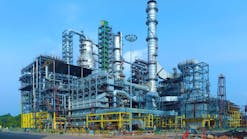Allen H. Smith
Willbros Butler Engineers Inc.
Tulsa
A new 2 million bbl crude-oil storage terminal has begun operating in Lincoln County, Okla., near Cushing.
Construction began in 1992. Initial operations with 700,000 bbl of storage began in the winter of 1993, and final operations with total storage began earlier this year.
Plains Terminal & Transfer Corp., subsidiary of Plains Resources Inc., Houston, built the terminal to satisfy storage-capacity shortfalls resulting from declines in U.S. production and from refiners' increased dependency on long-distance transportation of crude oil for feedstock.
Plains owns and operates the $24 million terminal which receives, stores, and ships segregated domestic and imported sweet and sour crude oil to major transporters in the Cushing interchange, the U.S.' largest crude-oil trading hub (OGJ, Apr. 1, 1991, p. 44).
Prime contractor Matrix Service Inc., Tulsa, says the terminal is the largest grassroots crude-oil terminal built in the U.S. in the past 10 years.
Serving as a major artery to Midcontinent refineries and as the physical delivery point of the New York Mercantile Exchange's light, sweet crude contracts, the terminal is open to producers, crude-oil traders, and marketers who require storage in the Cushing interchange for transactions on the futures and spot markets.
Major transporters include Amoco Pipeline Co., ARCO Pipe Line Co., Cush-Po Pipeline System (Conoco Pipe Line Co.), MidContinent Pipe Line Co., Ozark Pipeline System (Shell Pipe Line Corp.), Basin Pipe Line System (Texaco Pipeline Inc.), Osage Pipe Line Co. (Texaco Pipeline Inc.), and Sun Pipe Line Co. (Fig. 1).
CONTRACTORS; CONFIGURATION
Matrix provided design, procurement, and installation of tanks, buildings, fire protection, and cathodic protection (see accompanying box p. 87).
Willbros Butler Engineers Inc., Tulsa, was a subcontractor to Matrix to perform the design and procurement functions of the remaining facilities, as well as construction inspection, precommissioning, commissioning, and start-up and operating assistance.
These facilities included transfer pumps, meters, prover, oil-water separation system, central manifold, terminal piping, electrical, instrumentation, and supervisory control and data acquisition (scada) system.
Field services included site surveying, to set benchmarks and locate major equipment, and inspecting during construction to monitor conformity with construction drawings and specifications.
Craft and specialty inspection included welding, soil compaction, concrete tests, painting, electrical, instrumentation, and scada.
Crude-oil storage is provided in 18 floating-roof tanks on an 80-acre plot divided into three clusters with centrally located meters, prover, pumps, and manifold (Fig. 2).
The plan was based on safety codes, net positive suction head (NPSH) requirements for transfer pumps, economics, and minimizing encroachment on existing pipelines' rights-of-way.
Fourteen of the tanks are 120 ft in diameter and 48 ft high with a nominal capacity of 100,000 bbl. The remaining four tanks are 150 ft in diameter and 48 ft high with a nominal capacity of 150,000 bbl.
Seven of the 100,000-bbl tanks occupy the northeast cluster, the other seven are in the northwest cluster. The four 150,000-bbl tanks are located in the south cluster.
The tanks are equipped with mixers from Jensen Mixers International Inc., Tulsa; tank-level gauges distributed by L&J Engineering, Tulsa (previously Shand & Jurs); high-level alarms; and other appurtenances. The tank skin valves are 20-in. gate valves supplied by Zidell Valve Corp., Broken Arrow, Okla., with operators supplied by Rotork Controls Inc., Rochester, N.Y.
MANIFOLD AND PUMPS
Each tank cluster is served by two aboveground 24-in. OD trunk lines allowing simultaneous receipt and delivery of crude oil to each tank cluster. Dual lines from each tank connect to the trunk lines (Fig. 3). The six 24-in. trunk lines serving the three clusters are interconnected to a central manifold.
The central manifold is connected to transfer pumps which in turn connect to the meter skids. Offsite pipelines connect the meter skids to major transporters.
Fig. 4 presents a flow diagram; Fig. 5 a view of the mainfold, metering, and pumping area; and Fig. 6 a view of construction during manifold piping installation.
The central manifold provides the flexibility to ship to or receive from five offsite pipelines from any tank. The manifold also permits internal transfers between tanks.
The 36 manifold valves are Zidell gate valves with Rotork motor operators. The elevation of the piping continually drops from each tank to the transfer-pump inlet to provide a "drain-dry" system.
Pipeline-dedicated transfer pumps consist of four 11 canned" Ingersoll-Rand motor-driven pumps. One is also used for internal tank transfers.
Table 1 provides details of the transfer pumps and the pipelines they serve. Fig. 7 shows construction of receipt and shipping pipelines from the manifold area to off site pipelines.
The transfer pumps are designed to handle all crude oils in the Cushing interchange including Alaska North Slope, West Texas Intermediate, Louisiana Light Sweet, Midcontinent Sweet, Blend Light, Arabian Light, Mexican Isthmus, and Venezuelan Lago crude oil.
METERING
Five pipeline-dedicated meter skids fabricated by Smith Meter Inc., Corpus Christi, Tex., are provided for the terminal. The meters are served by a 16-in. bidirectional Smith prover.
Each meter skid includes a Smith Geo Flo flow computer contained in a meter console with a graphic panel located in the instrument building. The flow computers are connected to a Smith flow-supervisory computer in the main control room.
There are seventeen 10-in. meter runs each equipped with a Smith positive-displacement meter, 8-in. Fisher control valves, and General Twin Seal double block and bleed valves.
A dedicated sampler skid housed in a building is located upstream of each meter skid. Each sampler skid contains dual 10-gal containers and a sampling pump connected to a Tru-cut sampler located in a static mixer.
One static mixer serving Ozark was manufactured by Komax Systems Inc., Wilmington, Calif. The remaining static mixers were manufactured by Koflo Corp., Cary, Ill. Sampler skids were fabricated by Smith.
CONTROL, MONITORING
The scada system was programmed by Dillion Engineering Corp., Tulsa, for manual or automatic operation. The hardware for the scada system consists of dual 486DX 66-mhz microcomputers with 21-in. SVGA monitors. One computer serves as the master, the other as a hot standby.
A third 486DX 66-mhz computer is used as a network host between the master and the hot standby. A fourth 386DX 40-mhz microcomputer captures and stores all Smith meter reports using Digital Communications Associates' CROSSTALK.
Two printers are accessible by either the master or the hot standby. One printer is for report generation, the other for alarms and event logging.
Scada software operates in a Microsoft Windows environment.
The supervisory program is Intellution's FIXDMAC which provides operator interface and control functions.
The FIXDMAC program interfaces with a Smith Metering supervisory computer (486DX, 33-mhz), a Rotork Pakscan Master Station (moto-operated valve [MOV] and pump station system), and an L&j Tankway tank-gauging system (tank level and MOV operation).
Microsoft's Excel runs in the background and is used as a data base for 1,300 flow paths and as a report manager for tank volume and equipment run-time reports.
Excel is also used for flow-path conflict management, maintaining current flow-path configuration for each meter skid, and creating the resulting flow path which involves all MOVs in the terminal.
There are 127 MOVS, 18 control valves, 4 pumps, and 18 tank mixers controlled by the scada system. All tank-gauging functions, including dry API volume, are monitored and calculated by the scada system.
The scada system's reporting features include tank-volume reports, metering tickets, proving reports and equipment cycles, and run times. Figs. 8 and 9 display typical scada screens for meter skids and tankage.
Copyright 1994 Oil & Gas Journal. All Rights Reserved.


